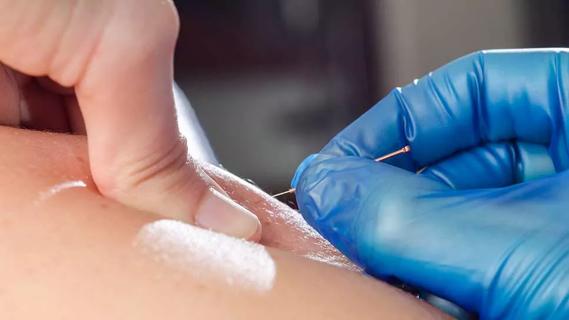Properly used, this herb may relieve joint and muscle pain

The quest for pain relief can sometimes feel like the world’s least compelling choose your own adventure book. There are so many options out there for addressing your various aches and ouchies, all with their own benefits and drawbacks. How do you decide which way to go?
Advertisement
Cleveland Clinic is a non-profit academic medical center. Advertising on our site helps support our mission. We do not endorse non-Cleveland Clinic products or services. Policy
While quick and easy, popping an over-the-counter pain pill isn’t always the best choice. Sometimes, an ice pack or a heating pad is the way to go instead. Other times, kinesio tape is your best bet. Gentle stretching or yoga might help. Maybe what you need is an acupuncturist or chiropractor’s touch. In some cases, you and your doctor may consider prescription medicines, or a procedure like dry needling or radiofrequency ablation. And some approaches to pain management are well-studied, while others remain experimental.
But no matter what you do, your experience is likely to differ from other peoples’ because pain isn’t static or standard.
And it can all get pretty confusing.
Arnica can be particularly puzzling. On the one hand, many people, and some studies, argue that it’s an effective pain reliever. On the other hand, those studies are pretty limited. Moreover, the word “poisonous” pops up a lot when you search for information about it. But you can also use it to flavor food? What the heck?!
We spoke to chiropractor Candice Price, DC, to learn what arnica is, how it may relieve pain and how to use it safely and effectively.
Arnica is a perennial, herbaceous plant with yellow or orange flowers that’s native to North America and most of Europe, with some species growing in India, Far East Russia and Japan. It’s been a player in traditional herbal medicine for centuries — particularly the Arnica montana species, which grows in Europe. That’s the species you’re most likely to encounter in commercial products.
Advertisement
Modern uses of arnica include the treatment of muscle pain (myalgia), joint pain (arthralgia), inflammation and bruising.
While generally safe and arguably effective when applied topically, arnica is no delicate flower. The herb contains a toxin called helenalin, which is deadly if consumed in large quantities. Arnica can be used to flavor food, but some countries have banned culinary use entirely, in an attempt to prevent accidental poisoning.
As you’ll see, when it comes to arnica, a combination of your personal medical history and the herb’s preparation determines how safe it is.
As Dr. Price puts it, “Arnica is a remedy that’s been used for centuries for a reason. There must be something to it that’s beneficial.”
But what, exactly? The fact is, our understanding of arnica remains limited. It’s a complex little plant!
“There are about 150 different bio-active components in arnica,” Dr. Price adds. “So, there are a lot of chemicals in there that have varying effects.”
While researchers have examined many of these components in isolation, Dr. Price explains that we haven’t necessarily studied the way these components come together in arnica to work on a human cell.
“Most of that research has been done in laboratory settings, on cells that have been taken from humans,” she says. “They’re just starting human research in a clinical setting.”
That means our understanding of arnica is stitched together based on what we know about its various components and how they behave. It’s an imperfect understanding, but it’s a start.
“We know, for example, that some components of arnica are antioxidant and cytoprotective — meaning they protect your cells,” Dr. Price continues. But she notes that other components — like helenalin — are cytotoxic. Again: There’s still there’s plenty of research to do if we want to truly understand arnica’s potential.
We may not fully understand arnica, but we do know that it relieves pain when applied to the skin. In fact, a 2007 study suggested it works just as well for hand osteoarthritis as topical NSAIDs.
“Arnica is very similar in how it works and functions to diclofenac and ibuprofen,” Dr. Price says.
In some studies, participants who used arnica had slightly fewer negative side effects than the participants using topical NSAIDs, but other studies found the exact opposite.
Bottom line (again): We need more research to fully understand arnica’s capacity to relieve pain.
There are many different ways to prepare arnica, but they aren’t created equal. Topical preparations are far and away the best and safest way to use the herb.
Advertisement
As Dr. Price states, “Oral formulations tend to be riskier. I don’t advise my patients to take those because there’s a lot more risk involved.
“Arnica is regulated like a supplement, not a medication. That means there isn’t a consistent dosage recommendation.” Not only is arnica under-researched, but Dr. Price also notes that the therapeutic dosing research that does exist is funded by arnica manufacturers.
Topical arnica products like creams, gels, foams, salves, roll-ons and ointments are the most common, safest and most effective way to use the herb.
In fact, it’s possible you’ve used arnica without realizing it.
“A lot of the FDA-regulated topical pain relief products and massage oils that exist out there have arnica in them,” Dr. Price says. “It’s snuck into a lot of products that people don’t realize.” That’s bad news for people who are allergic to the herb (more on that in a bit), but potentially good news for the rest of us.
That’s because, in 2021, a review of studies on herbal therapies for osteoarthritis concluded that arnica gel is about as effective as topical NSAIDs for inflammation and pain relief. There’s one big caveat, though: The findings were not clinically significant.
Advertisement
“I usually recommend arnica for reducing bruising and joint or muscle aches, but that recommendation is based on my patients’ experiences, not the current quality of research on the topic” Dr. Price states.
While not strict about the brand of arnica her patients use, she does encourage purchasing from manufacturers that are located in the U.K. or European Union, as they’re more tightly regulated than companies producing arnica products in the United States.
Depending on where you go on the internet, you may read that doctors recommend homeopathic arnica therapies. Maybe some doctors do, but they’re doing so despite a lack of scientific evidence suggesting that homeopathic remedies are safe or effective.
Dr. Price is straightforward about homeopathic arnica therapies: “You can try them at your own risk, but they’re not medically advised.”
Homeopathic medicines are made by diluting minute quantities of the active ingredient, so much so that it may not even be detectable. Most homeopathic arnica comes in tablet, tincture or dissolvable-pellet form.
Here’s the catch: If there are detectable levels of helenalin in the product you’re using, you’re at risk of health complications ranging from vomiting to organ damage and death. In other words, the safest homeopathic arnica products … contain next to no arnica.
Advertisement
Dr. Price adds, “There are a lot of homeopathic products out there made by less-than-reputable sources,” it’s probably best to steer clear of these products.
If you go shopping for arnica products, you may find them available in loose flower or tea form. While arnica is sometimes used to flavor food, it’s poisonous, and — according to the U.S. Food and Drug Administration (FDA) — not safe to consume in its pure form. In fact, some countries prohibit its use in food altogether.
The U.S. government doesn’t regulate arnica, so you can’t be completely sure how much of the toxic material you’re consuming when you eat or drink it. More on that later.
We all love a good DIY project, but when it comes to arnica, stay away from the homemade stuff.
“I recommend against buying arnica products from an unknown retailer, or from a random ‘mom and pop’ who cultivate the flower and make arnica tinctures at home,” Dr. Price stresses. Aside from quality control concerns, major manufacturers of arnica and products that contain arnica are more likely to be consistent in their dosing.
In 2020, the FDA sent warning letters to multiple companies selling injectable homeopathic products, including one company that was selling injectable arnica.
In those letters, the FDA explained that injectable drugs are far riskier than topical or ingested products, because they “are delivered directly into the body, sometimes directly into the bloodstream, and therefore, bypass some of the body’s key defenses against toxins and microorganisms that can lead to serious and life-threatening conditions.”
If you see a company — pharmaceutical or otherwise — selling arnica injections, avoid them completely.
When it comes to deciding if arnica is the right choice for you, it’s important to think of it like you would any other anti-inflammatory or pain medicine. It’s not right for everybody and can be dangerous if made or used improperly.
While arnica is sometimes used to flavor food, its cytotoxic properties render it poisonous in large amounts. For that reason, the FDA has classified the herb as unsafe, and the Canadian government has completely banned its use in food.
Depending on how much arnica you ingest, you could experience the following:
While homeopathic preparations of arnica (correctly manufactured) are unlikely to cause side effects, (1) there’s no scientific evidence that they work and (2) because it’s an unregulated substance, you can’t be sure that the product you’re using is safe.
Arnica creams and gels may be beneficial, but — just like over-the-counter pain medications — they’re not for everybody. You shouldn’t use arnica if:
If you aren’t a good candidate for topical arnica for one or more of the reasons listed above, don’t despair! There are plenty of other pain relief methods (beyond traditional NSAIDs) that you can try.
“People who want something that’s a little bit more natural and holistic for pain relief can look into chiropractic care, osteopathic manipulation, physical therapy, massage, acupuncture, yoga, meditation and even psychotherapy for pain management,” Dr. Price advises. “There are all sorts of different bio-psychosocial interventions you can explore with your healthcare provider.”
If you experience any of the following symptoms of an allergic reaction after using arnica topically, you should stop using it and contact your doctor.
If you find yourself having any other concerning symptoms, you should stop using the product and reach out to a healthcare provider.
Whenever you consider adding a new medication or herb into your routine, it’s best to speak with your doctor. It’s all the moreimportant to do so in the case of natural products — like arnica — that can be harmful if prepared (or taken) incorrectly. Your healthcare provider will work with you to ensure you experience the benefits of arnica without taking unnecessary risks.
Learn more about our editorial process.
Advertisement

Stretching, heating pads and massage guns can provide quick relief

Besides questionable effectiveness, herbal supplements aren’t safe for everyone

Both can help reduce pain, but they’re very different in terms of origins, philosophies and practices

As part of a larger treatment strategy, it can help decrease muscle tightness and reduce pain

Arthritis, migraines and endometriosis are common causes of chronic pain

Barometric pressure can play a role in joint pain, but that doesn’t mean you have to live with it

Find the right sleep position to tame your joint pain

Type 2 diabetes isn’t inevitable with these dietary changes

Applying a hot or cold compress can help with pain